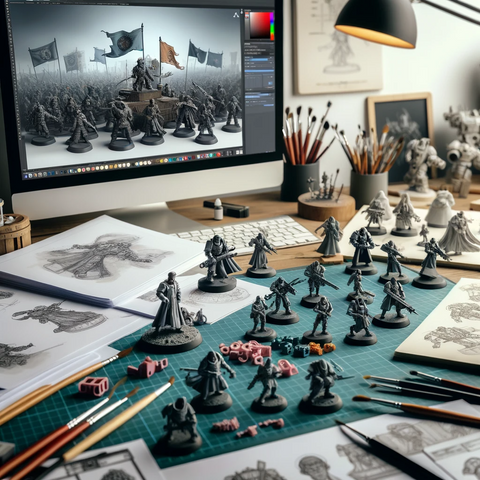
The Intricate World of Wargaming Miniatures: Design and Manufacture
Introduction
Wargaming miniatures are small-scale models used in tabletop wargames, representing soldiers, vehicles and terrain. These miniatures are not only game pieces but also works of art, reflecting intricate design and meticulous manufacturing processes. This article delves into the fascinating world of wargaming miniatures, exploring their design, manufacturing, and the culture surrounding them.
The Evolution of Wargaming Miniatures
The history of wargaming miniatures dates back to the 18th century, with Prussian military exercises using miniature figures. However, it was in the 20th century that they gained popularity in the realm of recreational wargaming. Early miniatures were crude representations, but over the decades, they have evolved into highly detailed models.
Many different companies design and manufacture miniatures, from small one person studios to giant multi-national corporations such as Games Workshop. They will all use different methods of design and manufacture that suits their style and budgets.
The Art of Miniature Design
Designing a wargaming miniature is a blend of art, history, and engineering. It begins with concept art, where designers sketch the initial idea. Historical accuracy is crucial for historical wargames, while fantasy and sci-fi genres allow for creative freedom.
Sculptors, traditionally working with clay or putty, now increasingly use digital tools to create 3D models. Digital sculpting allows for precision and the ability to easily modify designs. This stage is crucial, as it defines the detail, proportions, and character of the miniature.

Iterative Process
The design process can take days, weeks or months depending on the complexity and there are often two distinct considerations, how it looks and how it will be manufactured.
Looks are of course important and the concept designer and sculptor put their mark on the miniatures early on but once this has been achieved it will then be handed over to a manufacturing engineer who may alter the design slightly so that it can be successfully manufactured.
Depending on the manufacturing process there can be very few changes needed or it may need to be broken up into several smaller parts and put onto a sprue if it is to be injection moulded in plastic.
Let us discuss the difference in miniature materials.
Materials and Manufacturing
The choice of material for miniatures has evolved over the years. Initially, lead was common, but due to health concerns, it was replaced by safer materials like tin, resin, and plastic.
The manufacturing process varies based on the material:
Metal Miniatures: Often made from pewter, metal miniatures are produced using spin casting. Molten metal is poured into a rubber mold and spun to fill the details. Once cooled, the miniature is removed, trimmed, and cleaned.
Plastic Miniatures: Plastic miniatures are prevalent due to their durability and lower cost. They are produced using injection molding, where molten plastic is injected into a metal mold. This process is ideal for mass production but requires significant upfront investment in mold design.

Resin Miniatures: Resin casting is used for detailed and complex miniatures, especially for limited runs. Liquid resin is poured into a silicone mold and left to cure. Resin allows for capturing fine details, making it a favorite for collectors and high-quality models.
The Detailing Process
After casting, miniatures often undergo a process of cleaning to remove excess material and improve detail visibility. This is followed by assembly, which can range from simple one-piece models to complex kits requiring extensive assembly.
Painting and Customisation
One of the most appealing aspects of wargaming miniatures is the ability to paint and customize them. Painting miniatures is an art form, requiring skill and patience. Hobbyists use various techniques like dry brushing, washing, and layering to bring out details and create realistic effects.
Customization allows players to personalize their armies, adding uniqueness to their gameplay. This can involve modifying poses, swapping parts, or adding new elements.
Challenges in Design and Manufacture
Creating miniatures involves several challenges:
Detail vs. Durability: Balancing intricate detail with the durability required for gameplay is challenging. Too much detail can make a miniature fragile, while too little can make it unappealing.
Scale Consistency: Maintaining consistent scale across different miniatures and ranges is crucial for a coherent gaming experience.
Production Costs: High-quality molds for plastic miniatures are expensive, making initial investments significant.
Technological Advances
Advancements in technology are revolutionizing the design and manufacture of miniatures:
3D Printing: Increasingly accessible, 3D printing allows for rapid prototyping and even home production of miniatures. It opens up new possibilities for customization and small-scale production.

Digital Sculpting: Digital tools have made the design process more efficient and have expanded the potential for detail and creativity.
The Cultural Impact
Wargaming miniatures are more than just game pieces; they are a convergence of hobby, art, and community. Painting and customizing miniatures is a deeply personal experience, often shared within a vibrant community of hobbyists.
Competitions and conventions celebrate the artistry of miniatures, where hobbyists showcase their skill in painting and modeling. These events foster a sense of community and shared passion.
The Future of Miniature Wargaming
The future of wargaming miniatures is promising. With the integration of technology and the growing popularity of tabletop gaming, the hobby is reaching new audiences. The trend towards more detailed, diverse, and accessible miniatures continues, fueling the creative spirit of hobbyists around the world.
Conclusion
Wargaming miniatures embody a unique blend of artistic expression and gaming. From the intricate design process to the detailed manufacturing techniques, miniatures are a testament to craftsmanship and creativity.

This article was produced by Loaded Dice with the aid of ChatGPT.




